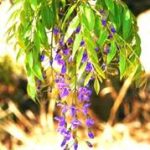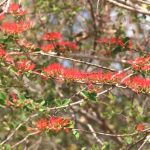TREE LIFE
February 1983
MASHONALAND CALENDAR
Tuesday February 1st : Botanic Garden Walk. Meet in the Car Park at 1646 hours for 1700 hours.
Monday 7th February : 1945 hours. Steven Mavi of the National Herbarium will give a talk on the “Medicinal Use of Plants” to the Wild Life Society in the Reimbarta Hall, Samora Machel Avenue East. Members of this Society will be welcome. There is a charge of 75c per head which includes the cost of hiring a Security guard to look after the cars.
Sunday February 20th : Lot 1 Ulladale, Mazowe which now belongs to John Graylin (he has not given it a proper/common name yet). We found Heteropyxis dehniae, Lavender Tree, and groves of Dalbergia melanoxylon, African Blackwood and have yet to explore the stream. A bus has been arranged and will leave the Monomatapa Car Park at 0900.
BOTANIC GARDEN WALK JANUARY 1983
Having commented in the notes on the last Botanic Garden Walk that we realized when we got home there were two Albizias which we had missed, Mr. Tom Muller decided that the first thing we should do on our walk in January was to rectify the omission. So we made straight for Albizia tanganicensis, paper bark Albizia with its characteristic pale stem peeling cinnamon coloured paper. This had been planted in 1967 and has developed into a very nice sized tree. When not peeling the pale trunk could possibly be confused with those of some of the Commiphoras and Sterculias but it is very white, almost opalescent and very smooth and of course in leaf or fruit totally distinctive. The leaves are bipinnate with a gland near the base of the petiole. The leaflets fall into the albizia medium sized category are slightly asymmetric, have small petiolules (leaflet stalks) and are pale green. (And I see that the one I picked to look at while writing these notes has a small apical hook, a sharp little point on the under surface of the rachis between the top pair of pinnae). The flowers are characteristic albizia flowers as are the pods but the pods are not as thickened at the edges as some of the other species.
On our way to find Albizia forbesii we passed Holarrhena pubescens, Jasmine tree, lovely in white flower. The bark of this species is in great demand for something and the tree has been almost completely ring-barked but it seems to have an internal phloem, or bark tissue and able to continue to exist. It has been treated presumably to help it heal and a notice in Shona is attached warning that parts of the tree may be unsafe to use. Tom speculated as to whether the notice might not be defeating its own purpose and that those with evil intentions might not now be encouraged to collect the bark even more readily. Ficus sycomorus, sycamore Fig was full of green fruit and Ficus vallis chaudae with its leaves large enough for the Garden of Eden was flourishing. Voacanga thousarsi was in full flower which as we passed reminded us of the smell of fresh dough. We did eventually find an Albizia forbesii. Apparently most of them have succumbed to Armellaria, a root fungus associated with land which has been cleared of Msasa. In parts of the Gardens a number of trees have been lost as a result of it. A. forbesii, an inhabitant of riverine vegetation on the triassic sands in the south east of the country where it probably gets a bit of winter guti and drizzle, was suffering from lack of water with the drought we have had this year and was only just coming into leaf. It is one of the small leafleted species.
We then turned our attention to the Terminalias which are members of COMBRETACEAE but which do not have opposite leaves as I had vaguely believed. They are best described as spirally arranged to bunched up or clustered at the ends of the branchlets. The pods are distinctive with a wing all the way round the central portion containing the seed. This only applies to African species as elsewhere some species have nuts. Terminalias are also inclined to have branches growing out at right angles giving the tree a layered look, rather like the floors of a multi-storey building.
Our introduction to this genus was Terminalia sambesiaca, a riverine species, which occurs in the northern part of the country but is not common. It has a smooth bark and so no adaptation against fires and only loses its leaves in November.
We then looked at the three species which occur in medium to low altitudes in hot areas. With them all together for comparison identification was obvious but I cannot help feeling that by themselves it might not be so easy, so I have listed the points that Tom mentioned and also those I have subsequently dug out of books. Terminalia prunioides, purple-pod Terminalia has arched drooping branchlets; the branchlets are straight and the hairy leaves are borne on spine-tipped spur shoots. Later, of course, we saw one which was glabrous (without hairs). In purple fruit which are over 4cm long, the largest of the three, this species is very striking. The specific name prunioides means plum like and refers to the colour of the fruit. The flowers are small and star like with an unpleasant smell, in fact, on one occasion, at Kariba the scent was so unpleasant that my friends irreverently christened it “Prunus vulgaris”.
Terminalia stuhlmannii, zig-zag Terminalia, has flat slightly ascending branches with branchlets that zig zag. The leaves which usually are glabrous, have veins prominent on the upper surface and margins tightly rolled under, are clustered on short lateral spurs which sometimes have spines at their bases.
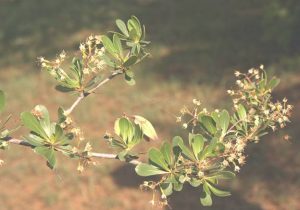
Terminalia randii. Photo: Bart Wursten. Source: Flora of Zimbabwe
Terminalia randii. Small leaved Terminalia, has the smallest leaves, usually without hairs, without prominent veins and without rolled under margins. In fact it has been described as looking rather like a hawthorn. The leaves are clustered on short woody bosses which occur in the axils of the spines which can be up to 10cm long. Perhaps this should be called the Spiny Terminalia.
We then turned our attention to Terminalia mollis, large-leaved Terminalia. This has large velvety leaves, (”mollis “ means soft) roundish in shape, spirally arranged around the branchlets and far enough apart to give the impression of being alternate. The branchlets eventually become corky. The fruits which seldom become more than pink tinged are the largest of the species. All of which help to separate T. mollis from Terminalia stenostachya, rosette-leaved Terminalia with its leaves more elongated and pointed, borne in rosettes on pink petioles and when they fall they leave hollows or leaf scars along the branchlets, which do not peel as do so many Terminalias and Combretums. I should like to emphasize the presence of the leaf scars, the absence of peeling and the pink petioles as it is only pure T. stenostachya which has these features.
Terminalia trichopoda may be a proper species but it is commonly thought to be a fertile hybrid of T. stenostachya and T. sericea. T. trichopoda does not have leaf scars and does have peeling branchlets and we were able to walk round the Gardens distinguishing between them on those features. The point was raised that while T. trichopoda occurs around Bulawayo, T. stenostachya does not and would that give support to T. trichopoda being its own species after all. Apparently it can happen that the parents of a hybrid become extinct and when that happens we have what is fascinatingly called a phantom hybrid.
Terminalia sericea, silver Terminalia or Mangwe has grey leaves with silvery silky hairs and frequently the branches grow at right angles to the trunk giving it a characteristic layered look. It is a minor component of sand veld but as soon as old lands are left dormant it is one of the first trees to become established. It is very resistant to fire and in fact the seed germinates better after it has been burnt. The Mangwe Pass near Masvingo derives its name from the presence of these trees which the early pioneers believed were the same as the Silver Trees (Leucadendron argenteum) of the Cape Peninsula.
Terminalia gazensis is a forest-edge and dry forest species and as such is slightly more drought resistant than some of the evergreen forest species. It is irregularly layered and its leaves are a special shade of green that makes one feel cool just looking at it. This is also an early colonizer, this time in cleared forest areas.
Lastly there was Terminalia brachystemma, another species of low altitude hot areas, particularly on Kalahari sand. It is a little like T. sericea but has no hairs and almost no petiole.
I have not mentioned the bark as a distinguishing feature as they are all very similar “longitudinally fissured”. The galls are also common to several species and the Terminalia comes from the fact that the leaves are usually terminal, i.e. borne at the end of the branches.
Thank you Tom for opening our eye to their differences. Previously we have tended to ignore those we do not know and I trust that will no longer be the case.
-Kim St.J. Damstra
SERUI RIVER JANUARY 1982
In November when we decided that we would choose the Serui River where the Bulawayo road crosses it for the second time just beyond Selous, as a venue for our January outing we mentally added the proviso that if it rained we would take over the Selous Hotel and have a quiz. We did wonder how full the Serui would be and whether a riverine walk would be practical or even possible in January and I would like to assure everyone that despite popular belief I have no more influence over the weatherman than I have over the petrol man and therefore I am not responsible for either drought. 28 people made it to the bus, perhaps I should say 28 and a seedling as Cheryl and Phil Haxen brought along wee Jessica, just seven weeks old and as good as gold.
While everyone was getting off the bus we had a look at Bolusanthus speciosus, Tree Wisteria, its compound leaves bearing sickle-shaped leaflets which distinguish it from Mundulea sericea, cork bush, which we saw frequently later on. I must confess I wondered why I was pointing out the difference as on this occasion they were so dissimilar. All the Munduleas were much smaller, more shrub like and their leaflets were small, stiff, lance shaped, grey green and covered with silver hairs in complete contrast to the bright green dropping leaflets of Bolusanthus. Perhaps a lack of rain was having its effect on the Munduleas. Both species belong to the family LEGUMINOSAE subfamily PAPILIONOIDEAE.
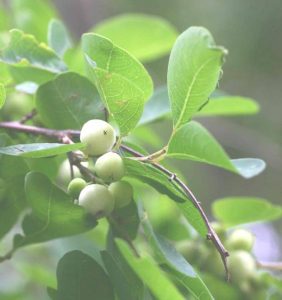
Securinega virosa, Photo: Bart Wursten. Source: Flora of Zimbabwe
We crossed the road and there was Securinega virosa, Snowberry Tree, full of berries almost ripe and white, in such profusion that we wondered why they had not been eaten by the birds.
Securinega is a member of the EUPHORBIACEAE family is widely distributed in Asia and Africa. Eve Palmer in Trees of Southern Africa, Vol. II says ‘the fruit is small, round and in South Africa, white and slightly fleshy’ which seems a strange way of putting it. We know this is true for Zimbabwe and it appears to be true for Kenya but I have been unable to establish if there is any variation in other parts of the world.
Once we got down to the river bank we seemed to find one thing after another to exclaim about including comment of where the water had risen in previous years as evidenced by clumps of driftwood well above our heads in some places. There were large Rhus lancea, willow Rhus, its shiny green trifoliolate leaves on long petioles graceful and drooping contrasting with the black rough bark. The generic name Rhus is thought to come from a Greek word meaning red in reference to the fact that some species turn red in autumn. And talking of red, there is no doubt about the origin of the specific name of Combretum erythrophyllum (erythos – red and phylum – leaf) the river Combretum which was prevalent each time slightly different and ready to confuse us, but its pale trunk with its cats claw marks always a distinguishing factor with the opposite leaves as confirmation. With alternate leaves was Salix subserrata, wild willow right on the edge of the water and probably partly submerged during floods. The leaves were darkish blue green on top and silvery grey to almost white underneath borne on red petioles on reddish stems. This was another species whose name we discussed and to quote from our Dictionary of Scientific Terms – “Latin: sub – under; serra – saw. Somewhat notched or saw toothed”. The leaves of Nuxia oppositifolia River Nuxia also have margins that are somewhat notched but as the name implies they are opposite and more or less the same colour on both sides. We were lucky to find one with a lovely head of white flowers. To add to our quota of essentially riverine species there was the River Rhus, Rhus quartiniana, described as a willow like shrub. Certainly the stems seem to flow with the river as do those of Salix but otherwise it has the characteristic Rhus trifoliolate leaves with a yellowish tinge and not nearly as willow like as those of Rhus lancea.
A tree standing out from the others because of its distinctive dusty blue green appearance was Olea europaea subsp. africana. This has opposite leaves, glossy when caught by the sun otherwise slightly dull on the upper surface and below covered with silvery golden or brown scales. As a bonus our Wild Olive was full of young green fruit. This used to be called O. africana but the botanists have decided that it is the same species as the cultivated olive of Europe, although a different subspecies with a much smaller non-commercial fruit and which perhaps explains why grafting of the Mediterranean commercial olive on to stock from our indigenous trees has been a success particularly in the Cape.
Also in fruit but this time ripe we found both Sour Plums, both sour but for those who tried them rather refreshing in the middle of a hot dry day. Ximena americana and Ximenia caffra were easily separated. X. americana, small sour plum with its blue green glabrous leaves and orange fruit with more than one to a stalk and X. caffra its leaves a more yellow green and hairy and its fruits a bright red so for a change there was no mistaking which was which.
It took a little while and discussion to decide the identity of a tall tree with a palish stem whose leaves were acquired with difficulty. Eventually we decided that it must be Securidaca longipedunculata, violet tree. Having reached that conclusion someone found an old seed pod on the ground confirming our identification.
Acacia rehmanniana was in flower which take the form of white balls demonstrating another difference between it and Acacia karroo whose flowers are yellow balls and which appeared to be everywhere. Acacia nilotica also has yellow flowers and we probably saw it, as it occurs in that area, but we did not recognize and record it as we were mistaking it for A. karroo without its reddish brown branches. This is the second time recently when I have been uncertain which is which without the pods to tell me. The pods, of course, are very distinctive. A. karroo has a dehiscent pod slender, woody, sickle shaped and slightly constricted between the seeds. The pod of A. nilotica is indehiscent and looks rather like a string of beads because there are round bumps where the seeds are. The following notes of the apparent differences have not been proved in the field and apply only as a comparison between these two species.
| A.karroo
|
A.nilotica |
| Young branchlets, young thorns and petioles slightly hairy to glabrous | Young branchlets, young thorns and petioles slightly hairy to densely so |
| Thorns not joined at the base and thickest about the middle | Thorns have a common base and are thickest just above the base |
| Thorns straight | Thorns tend to curve back |
| Single leaf per node in notch between thorns on young growth. On older growth up to 8 leaves on black cushion | Primary leaf in notch between thorns large surrounded by smaller leaves
|
| Leaf (petiole and rachis) 5 – 10cm long | Leaf (petiole and rachis) up to 5cm long |
| Shortest pair pinnae at base, largest about 1/3 way from apex | Shortest pair pinnea at base all others same size |
| Midrib bisects leaflet asymmetrically | Midrib bisects leaflet symmetrically |
| Leaflet margin glabrous | Leaflet margin ciliate |
| Gland on petiole large, gland between pinnae smaller | Gland on petiole same size as glands between pinnae (unusual) |
The above seems to prove that they are so different, how was I ever in doubt.
We re-crossed the main road and found ourselves in a totally different type of vegetation. Perhaps the road was sited on a high spot, a dividing line a different rainfall, or different geologically or different as a result of pure coincidence.
There were lots of Terminalia randii, small leaved Terminalia, which was very exciting as I think this is the first time it has been recorded on an outing. A description of it is included in the Botanic Garden Walk so I will not bore you with a repetition. And to add to the excitement of that area the mopane were in flower, a sight we do not often see. The last lap back to the bus was a along a road which was unshaded and hot but along the side was lots of interest. Bauhinia thonningii, monkey bread, was in flower, as was Dichrostachys cinerea, its Chinese lanterns a perfect pink and yellow and some had faded leaving behind tiny developing pods. We satisfied ourselves that we had been able to separate Terminalia stenostachya with its leaf scars and no peeling on the twigs, from Terminalia trichopoda, peeling twigs and no leaf scars.
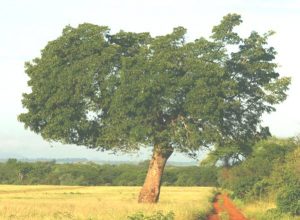
Afzelia quanzensis. Photo: Bart Wursten. Source: Flora of Zimbabwe.
It was hot but the Afzelia quanzensis, pod mahogany, where we had lunch offered shade and comfort and there was a bit of a breeze which increased as the afternoon wore on so that we were able to cool off.
After lunch the energetic tackled the kopje – in fact the tackle involved a gentle ascending stroll and once again many of the trees were different from those we had seen during the morning and we ticked off another bevy of beauties during the afternoon. Croton gratissimus, lavender Croton its buds forming ready to flower next October; Elephantorrhiza goetzei with green strap like pods; Strychnos potatorum, its dark green leaves distinctly 3 veined from the base; Gardenia ternifolia with its bark rubbing powdery as was the Strychnos with the small fruit, Strychnos innocua, who identification has definitely been confirmed. We found Friesodielsia obovata in flower including in one flower the tiny sausages just starting to develop and Bridelia mollis which looks so similar but has a much more velvety leaf which is not so blue green on the under surface and a closer look revealed the presence of old small knobby flowering and fruiting twigs confirming its relationship to B. cathartica, which we also saw on that occasion.
At the end of the day we had recorded 105 species on our cards including Cassine transvaalensis, with its small serrate leaves tightly clustered on short side shoots which we saw near the river and Tricalysia angolensis, the rubiate with small green fruit which we found on the kopje.
As everyone was boarding the bus we measured the trunk of our Pod Mahogany and it did take three of us with arms outstretched to circumpose the trunk. And so we left a lovely spot which in future as we drive past will no longer be the bridge beyond Selous but a place with a fascination of trees which we have had an opportunity to explore.
-Meg Coates Palgrave
AYRSHIRE BRANCH
The AGM was held in November at which Mrs. Gill Henderson in her Chairman’s Report told the members that the Branch has increased to 22 local people. New members were Mr. and Mrs. Hugh Gunell, Mr. and Mrs. Nigel Fernsby and family (whose family are definitely embryo tree walkers) and Mr. Stan Fourie of the Raffingora Rural Council, who grows indigenous trees, especially acacias.
Having joined the Tree Society these are the events which can be anticipated; 1 or 2 tree walks locally; a combined outing with the Harare members; A Field afternoon for the indigenous people. A visit to the National Monument at M’Bagazewa, where it is hoped to make a Nature Trail, label the trees and eventually, after much observation, produce a pamphlet on all aspects of the National Monument and Ancient Park.
The Chairman mentioned all the happenings since the last AGM. On December 5th 1981 two trees donated by Mrs. Coates Palgrave were planted in the grounds of the Raffingora Council Office. The Kigelia (sausage tree) is now 2 meters high, the African Wattle was run over by a tractor, then the drought killed it.
February 21st 55 people attended an Ayrshire/Harare tree walk amongst the granite kopjes on Nkodzwi farm by kind invitation of Mr. and Mrs. John Duffield. The Chairman thanked Ann and John for their hospitality and the farmhouse fare refreshments which were enjoyed by all, especially the visitors from town.
May 23rd Tree walk at the National Monument at M’Bagaewa where Meg and Paul Coates Palgrave identified the trees, the list of species has been filed. This outing was well attended by members and their friends.
On September 19th all three branches of the Tree Society met at Sable Park, Que Que. Miss Janet Webber brought members from Bulawayo and Mrs. Graves represented Ayrshire Branch.
October 7th Mr. and Mrs. Graves fielded an event at Katawa School where two films were shown, these were followed by a demonstration of how to preserve Woodland Re-growth. The practical work done by Mr. George Hall was photographed by Meg Coates Palgrave. Mr. James Gandari spoke in Shona to about 80 people and this was followed by a lively question time. The Chairman recalled that one did not have to understand Shona to get the answers to the questions because Mr. Gandari’s actions spoke better than words! A traditional ‘thank you’ was accorded to Mrs. Graves by the farmers’ employees, which rewarded her and her cook for making sandwiches and biscuits for Africa.
The Chairman ended her report by calling on Mr. Gordon to give advice on Eucalyptus plantations. He stressed the importance of continuity. The farmer should plant 5 acres of trees every second year until 15 – 20 acres are established, these should provide fuel wood and poles for several decades, since there are 5 – 6 harvests in the life of a gum tree. Advice about suitable varieties for each locality and for the production of poles may be obtained from the Forestry Commission , Mr. Cant. Gum trees will not ruin land; after removal of stumps the next annual crop will not suffer. Take care to select good land for gums, avoid heads of vleis because if planted there, they may dry up the streams. A dieback not entirely due to drought was being investigated at Trelawney, this may be caused by a fungus. Mr. Gordon was asked whether his employees disliked gum fuel wood, he replied that it was not a problem, however, when he provided Australian Cypress (Callitris) they resisted that at first but now burn it despite the sparks and fireworks, this is the way bamboo burns, which is disappointing since it is so hardy and fast growing.
The following people were elected to the committee
Mr. Stan Fourie Chairman
Mrs. B. Graves Secretary
Messrs. I. Barron, N. Fernsby
Mesdames G. Henderson, E. Jones, M. Malan
MATABELELAND BRANCH CALENDAR
At the recent AGM of the Branch Mrs. Dora Webb was re-elected Chairman and Mr. Cyril Wigg as Secretary/Treasurer. Ken Blake is starting the records of the Society and his sister Betty will do the typing.
And that concludes my last Newsletter as Chairman. I should like to take this opportunity of thanking you all for your interest and encouragement during the time I have been responsible for the Newsletter and to those who have written to me I shall be replying.
-Meg Coates Palgrave Chairperson


